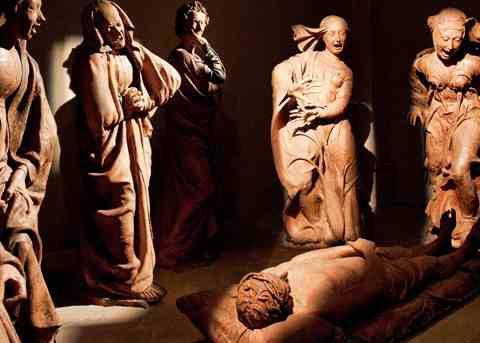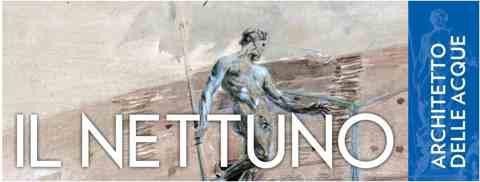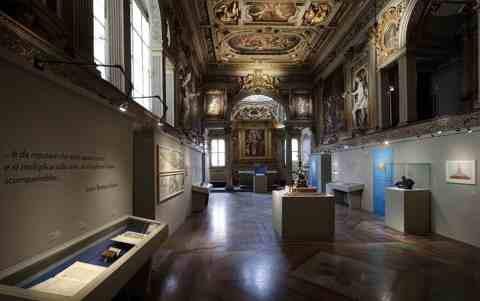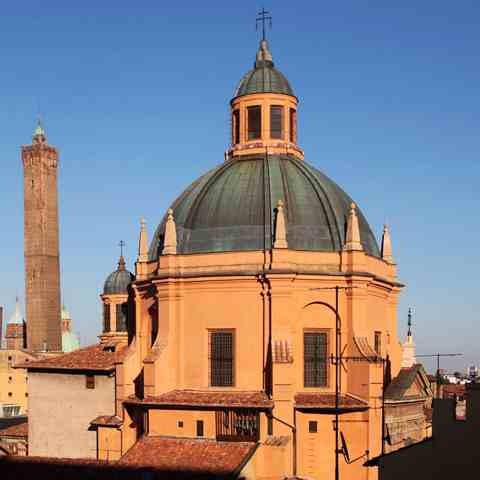MUSEUM AND ORATORY OF SANTA MARIA DELLA VITA
MUSEUM AND ORATORY OF SANTA MARIA DELLA VITA
The monumental complex of Santa Maria della Vita was built in the thirteenth century as a hospital and church, the latter
with the dome designed by Bibiena, it is the most important example of Bolognese Baroque and houses within it the famous Lamentation over the Dead Christ by Niccolò dell'Arca, the "stone scream", according to the famous definition of D'Annunzio,
Adjacent to the church is the Oratory, with the sculptural group of the Transito della Vergine by Alfonso Lombardi, and the Museum of Health and Care, in addition to the Gregorian Schola Benedetto XVI,
From 1814 the complex became the Ospedale Maggiore until the bombings of 1943, when it was razed to the ground.
The Sanctuary and its appurtenances form the heart of the historic center of Bologna, the so-called Quadrilateral; restored, since 2010 has assumed its current function as a museum and exhibition center.
THE LAMENTATION

The Lamentation over the Dead Christ is the masterpiece of Niccolò dell'Arca housed in Santa Maria della Vita.
It is a work made up of seven life-sized figures in terracotta with traces of polychrome, which is presumed to have been made between 1463 and 1490 and of which the exact arrangement of each figure is unknown. The dead Christ is in the center, lying with his head resting on a pillow.
All around the body there are the other figures, among which stand out the two women, torn by pain and with clothes swelled by the wind. The figure of the client, addressed to the spectator, in renaissance clothes, is detached from the others.
www.inbologna.it è gestito dall'Associazione
AltriTurismi

Supporta la nostra Associazione
FAI UNA DONAZIONE !Il Nettuno: architetto delle acque

The Neptune: architect of the waters
Bologna, the water for the city between the Middle Ages and the Renaissance
The exhibition – realised with the help of the Department of Architecture at the University of Bologna – will take visitors through one of the most intriguing chapters in the history Bologna, narrating, for the first time, the story of how the city’s public fountains were built in the period when Pope Pius IV was renovating the city centre.
The Fountain of Neptune is an iconic monument, and the fitting conclusion to an extraordinary season of visionary and grandiose architectural and hydraulic works that still grace the city’s centre and its public spaces.
Water, the Fountain’s main feature, is once again springing from the newly restored masterpiece. Hidden mechanisms direct its action, revealing a complex and secret narrative of water, with its network of aqueducts, water canals and pipelines that outline the underground city and describe a scenery that is both invisible and utterly surprising.
The invention of Bologna, city of waters, can be traced back to 16th century projects that were undertaken in the spirit of highlighting the close links between city and water. Making use of selected works, documents and other material, the exhibition in Santa Maria della Vita illustrates the genesis of the project and the development of the Fountain of Neptune’s water system, starting from the Middle Ages and ancient Roman times to the infrastructural work of the Renaissance.
from March 16th to June 10th 2018
how to get to the Museum
stop at Piazza Maggiore or via Rizzoli
Shuttle A: Piazza Galvani stop
Train: 15 minutes walk from Central Station
Parking: Underground parking in Piazza VIII Agosto
contacts - timetable - fares

Museum and Oratory of Santa Maria della Vita
via Clavature 8-10, Bologna,
tel. +39 051 230260
santamariadellavita@genusbononiae.it
Opening
Tuesday, Wednesday, Thursday, Friday, Saturday, Sunday: 10 am-7pm
Lamentation: 10.30-18.30
www.inbologna.it è gestito dall'Associazione
AltriTurismi

Supporta la nostra Associazione
FAI UNA DONAZIONE !Events in ... Bologna
the events - day by day- an easy way to organize your visit or your evenings


